AINV 12004 - Accident Investigation and Forensics Unique to Rail
VerifiedAdded on 2023/06/08
|7
|1446
|316
Report
AI Summary
This report delves into the unique aspects of accident investigation and forensics within the rail domain. It examines the specific laws, technologies, operational characteristics, and hazards inherent in rail transport, including the role of the Office of the National Rail Safety Regulator (ONRSR) and the Australian Transport Safety Bureau (ATSB). The report outlines key definitions for accident reporting, distinguishing between Category A and B notifiable occurrences, and discusses prescribed procedures such as James Reason’s System Safety Management, the Swiss Cheese Model, and the Human Factors Analysis and Classification System (HFACS). Furthermore, it explores forensic methods unique to the rail domain, such as data recorders (OTMR) and event loggers, which aid in understanding accident causation and improving safety measures. The report emphasizes the responsibilities of rail transport operators, rail safety workers, and the public in maintaining safety within the rail environment.
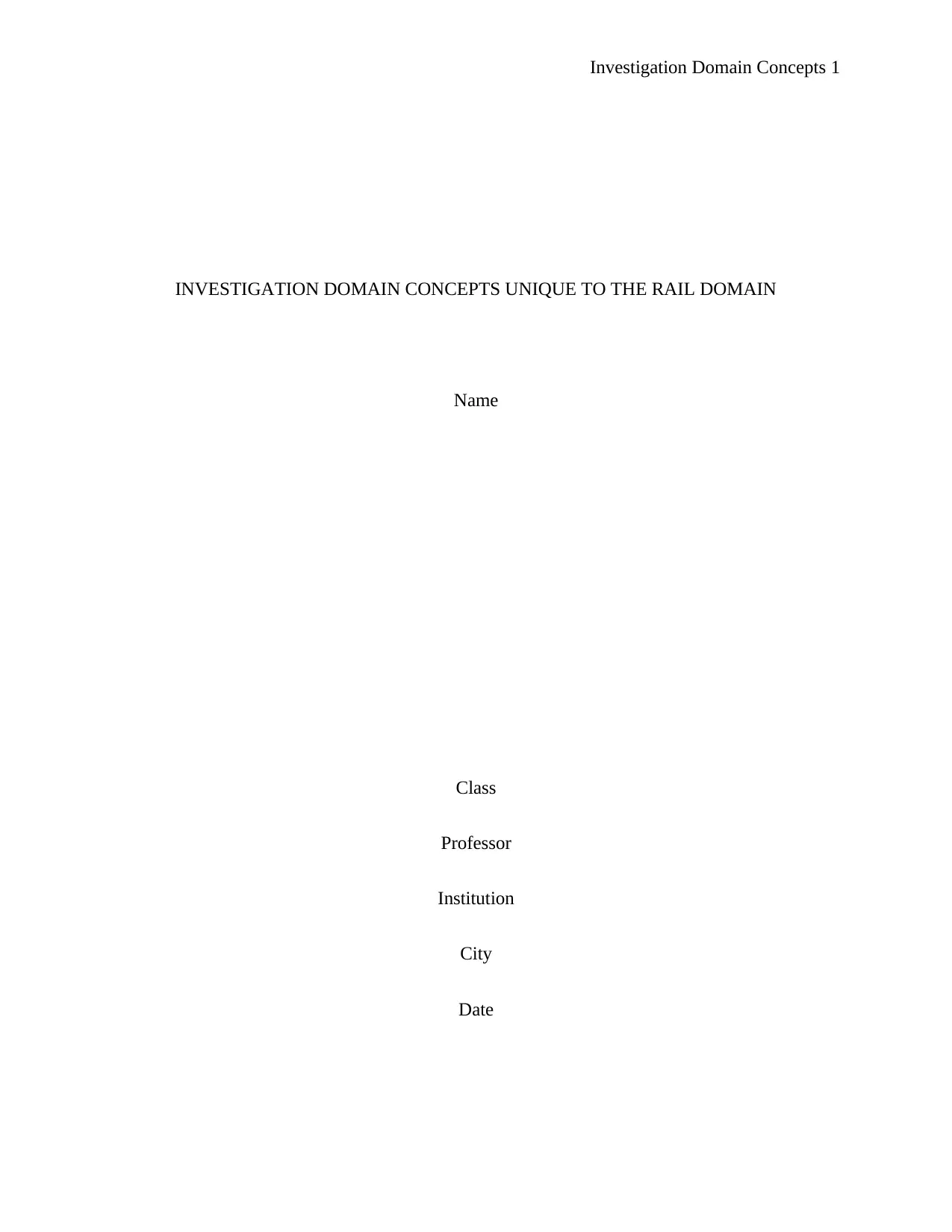
Investigation Domain Concepts 1
INVESTIGATION DOMAIN CONCEPTS UNIQUE TO THE RAIL DOMAIN
Name
Class
Professor
Institution
City
Date
INVESTIGATION DOMAIN CONCEPTS UNIQUE TO THE RAIL DOMAIN
Name
Class
Professor
Institution
City
Date
Paraphrase This Document
Need a fresh take? Get an instant paraphrase of this document with our AI Paraphraser
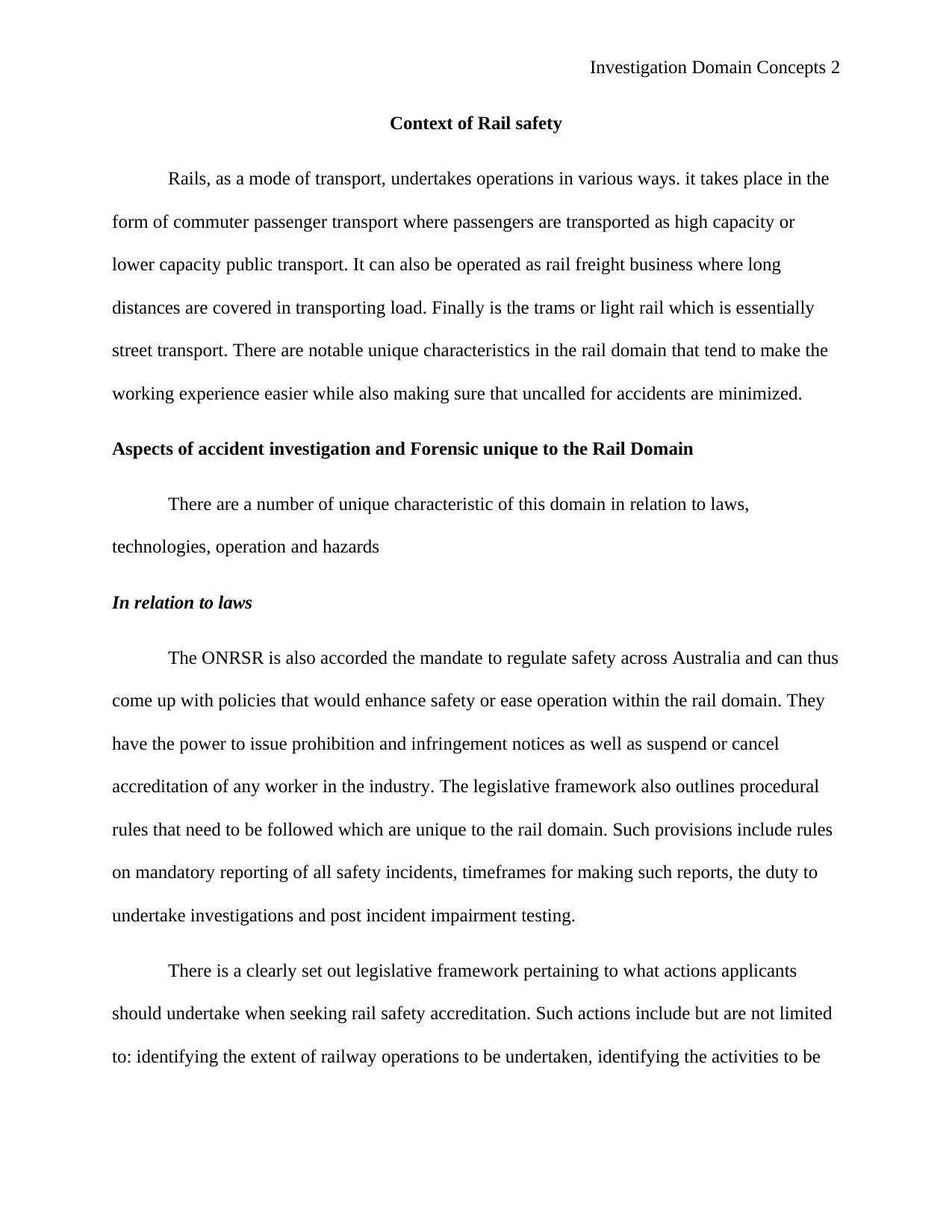
Investigation Domain Concepts 2
Context of Rail safety
Rails, as a mode of transport, undertakes operations in various ways. it takes place in the
form of commuter passenger transport where passengers are transported as high capacity or
lower capacity public transport. It can also be operated as rail freight business where long
distances are covered in transporting load. Finally is the trams or light rail which is essentially
street transport. There are notable unique characteristics in the rail domain that tend to make the
working experience easier while also making sure that uncalled for accidents are minimized.
Aspects of accident investigation and Forensic unique to the Rail Domain
There are a number of unique characteristic of this domain in relation to laws,
technologies, operation and hazards
In relation to laws
The ONRSR is also accorded the mandate to regulate safety across Australia and can thus
come up with policies that would enhance safety or ease operation within the rail domain. They
have the power to issue prohibition and infringement notices as well as suspend or cancel
accreditation of any worker in the industry. The legislative framework also outlines procedural
rules that need to be followed which are unique to the rail domain. Such provisions include rules
on mandatory reporting of all safety incidents, timeframes for making such reports, the duty to
undertake investigations and post incident impairment testing.
There is a clearly set out legislative framework pertaining to what actions applicants
should undertake when seeking rail safety accreditation. Such actions include but are not limited
to: identifying the extent of railway operations to be undertaken, identifying the activities to be
Context of Rail safety
Rails, as a mode of transport, undertakes operations in various ways. it takes place in the
form of commuter passenger transport where passengers are transported as high capacity or
lower capacity public transport. It can also be operated as rail freight business where long
distances are covered in transporting load. Finally is the trams or light rail which is essentially
street transport. There are notable unique characteristics in the rail domain that tend to make the
working experience easier while also making sure that uncalled for accidents are minimized.
Aspects of accident investigation and Forensic unique to the Rail Domain
There are a number of unique characteristic of this domain in relation to laws,
technologies, operation and hazards
In relation to laws
The ONRSR is also accorded the mandate to regulate safety across Australia and can thus
come up with policies that would enhance safety or ease operation within the rail domain. They
have the power to issue prohibition and infringement notices as well as suspend or cancel
accreditation of any worker in the industry. The legislative framework also outlines procedural
rules that need to be followed which are unique to the rail domain. Such provisions include rules
on mandatory reporting of all safety incidents, timeframes for making such reports, the duty to
undertake investigations and post incident impairment testing.
There is a clearly set out legislative framework pertaining to what actions applicants
should undertake when seeking rail safety accreditation. Such actions include but are not limited
to: identifying the extent of railway operations to be undertaken, identifying the activities to be
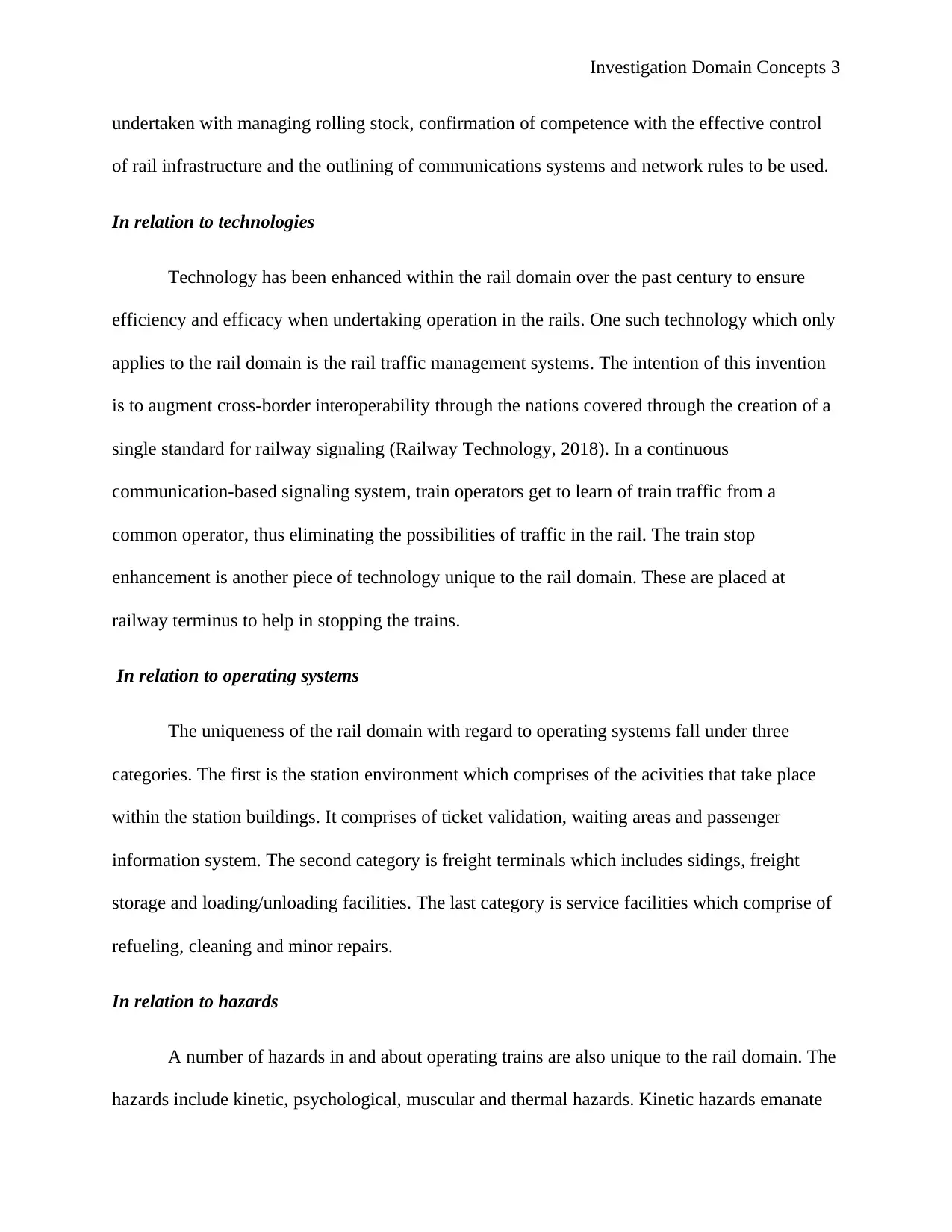
Investigation Domain Concepts 3
undertaken with managing rolling stock, confirmation of competence with the effective control
of rail infrastructure and the outlining of communications systems and network rules to be used.
In relation to technologies
Technology has been enhanced within the rail domain over the past century to ensure
efficiency and efficacy when undertaking operation in the rails. One such technology which only
applies to the rail domain is the rail traffic management systems. The intention of this invention
is to augment cross-border interoperability through the nations covered through the creation of a
single standard for railway signaling (Railway Technology, 2018). In a continuous
communication-based signaling system, train operators get to learn of train traffic from a
common operator, thus eliminating the possibilities of traffic in the rail. The train stop
enhancement is another piece of technology unique to the rail domain. These are placed at
railway terminus to help in stopping the trains.
In relation to operating systems
The uniqueness of the rail domain with regard to operating systems fall under three
categories. The first is the station environment which comprises of the acivities that take place
within the station buildings. It comprises of ticket validation, waiting areas and passenger
information system. The second category is freight terminals which includes sidings, freight
storage and loading/unloading facilities. The last category is service facilities which comprise of
refueling, cleaning and minor repairs.
In relation to hazards
A number of hazards in and about operating trains are also unique to the rail domain. The
hazards include kinetic, psychological, muscular and thermal hazards. Kinetic hazards emanate
undertaken with managing rolling stock, confirmation of competence with the effective control
of rail infrastructure and the outlining of communications systems and network rules to be used.
In relation to technologies
Technology has been enhanced within the rail domain over the past century to ensure
efficiency and efficacy when undertaking operation in the rails. One such technology which only
applies to the rail domain is the rail traffic management systems. The intention of this invention
is to augment cross-border interoperability through the nations covered through the creation of a
single standard for railway signaling (Railway Technology, 2018). In a continuous
communication-based signaling system, train operators get to learn of train traffic from a
common operator, thus eliminating the possibilities of traffic in the rail. The train stop
enhancement is another piece of technology unique to the rail domain. These are placed at
railway terminus to help in stopping the trains.
In relation to operating systems
The uniqueness of the rail domain with regard to operating systems fall under three
categories. The first is the station environment which comprises of the acivities that take place
within the station buildings. It comprises of ticket validation, waiting areas and passenger
information system. The second category is freight terminals which includes sidings, freight
storage and loading/unloading facilities. The last category is service facilities which comprise of
refueling, cleaning and minor repairs.
In relation to hazards
A number of hazards in and about operating trains are also unique to the rail domain. The
hazards include kinetic, psychological, muscular and thermal hazards. Kinetic hazards emanate
⊘ This is a preview!⊘
Do you want full access?
Subscribe today to unlock all pages.

Trusted by 1+ million students worldwide
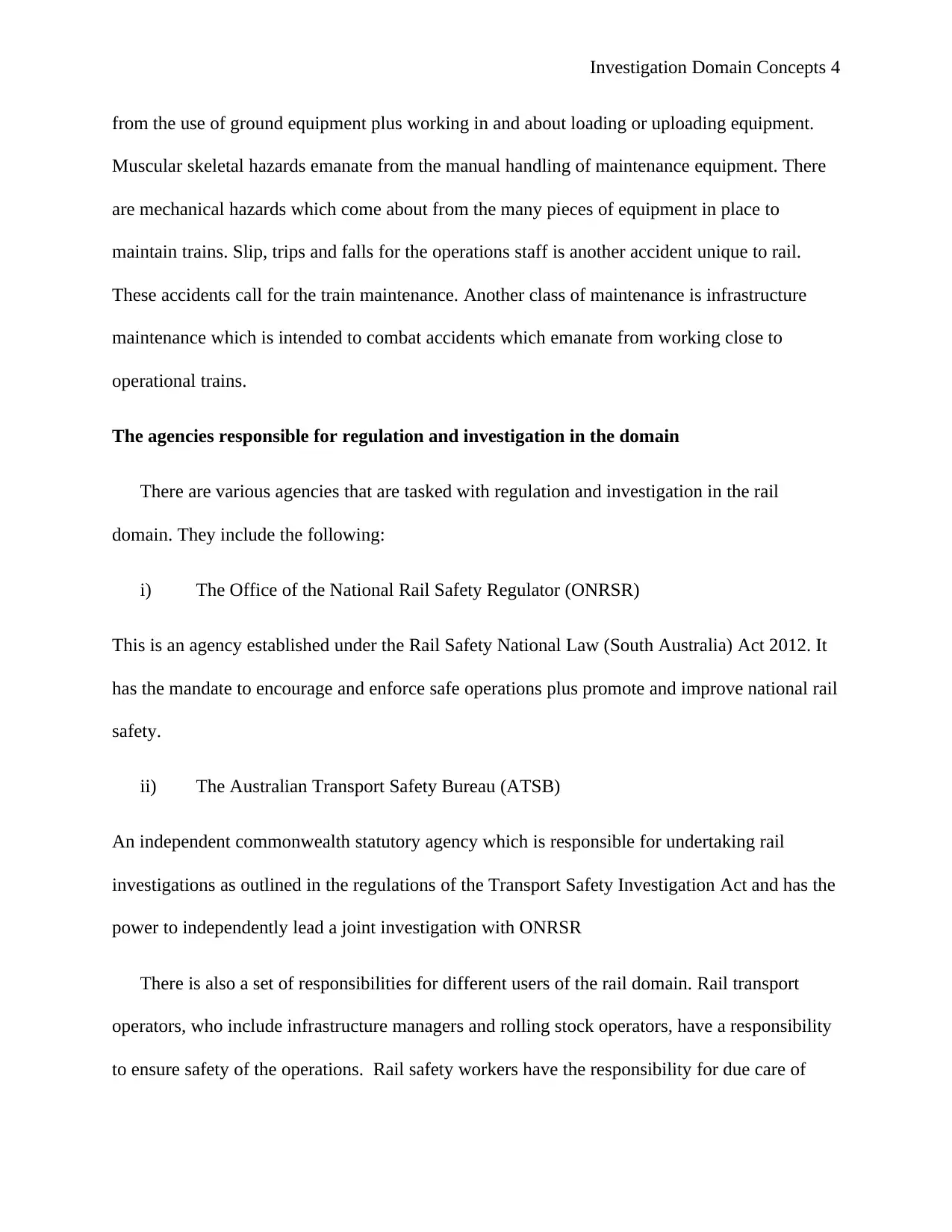
Investigation Domain Concepts 4
from the use of ground equipment plus working in and about loading or uploading equipment.
Muscular skeletal hazards emanate from the manual handling of maintenance equipment. There
are mechanical hazards which come about from the many pieces of equipment in place to
maintain trains. Slip, trips and falls for the operations staff is another accident unique to rail.
These accidents call for the train maintenance. Another class of maintenance is infrastructure
maintenance which is intended to combat accidents which emanate from working close to
operational trains.
The agencies responsible for regulation and investigation in the domain
There are various agencies that are tasked with regulation and investigation in the rail
domain. They include the following:
i) The Office of the National Rail Safety Regulator (ONRSR)
This is an agency established under the Rail Safety National Law (South Australia) Act 2012. It
has the mandate to encourage and enforce safe operations plus promote and improve national rail
safety.
ii) The Australian Transport Safety Bureau (ATSB)
An independent commonwealth statutory agency which is responsible for undertaking rail
investigations as outlined in the regulations of the Transport Safety Investigation Act and has the
power to independently lead a joint investigation with ONRSR
There is also a set of responsibilities for different users of the rail domain. Rail transport
operators, who include infrastructure managers and rolling stock operators, have a responsibility
to ensure safety of the operations. Rail safety workers have the responsibility for due care of
from the use of ground equipment plus working in and about loading or uploading equipment.
Muscular skeletal hazards emanate from the manual handling of maintenance equipment. There
are mechanical hazards which come about from the many pieces of equipment in place to
maintain trains. Slip, trips and falls for the operations staff is another accident unique to rail.
These accidents call for the train maintenance. Another class of maintenance is infrastructure
maintenance which is intended to combat accidents which emanate from working close to
operational trains.
The agencies responsible for regulation and investigation in the domain
There are various agencies that are tasked with regulation and investigation in the rail
domain. They include the following:
i) The Office of the National Rail Safety Regulator (ONRSR)
This is an agency established under the Rail Safety National Law (South Australia) Act 2012. It
has the mandate to encourage and enforce safe operations plus promote and improve national rail
safety.
ii) The Australian Transport Safety Bureau (ATSB)
An independent commonwealth statutory agency which is responsible for undertaking rail
investigations as outlined in the regulations of the Transport Safety Investigation Act and has the
power to independently lead a joint investigation with ONRSR
There is also a set of responsibilities for different users of the rail domain. Rail transport
operators, who include infrastructure managers and rolling stock operators, have a responsibility
to ensure safety of the operations. Rail safety workers have the responsibility for due care of
Paraphrase This Document
Need a fresh take? Get an instant paraphrase of this document with our AI Paraphraser
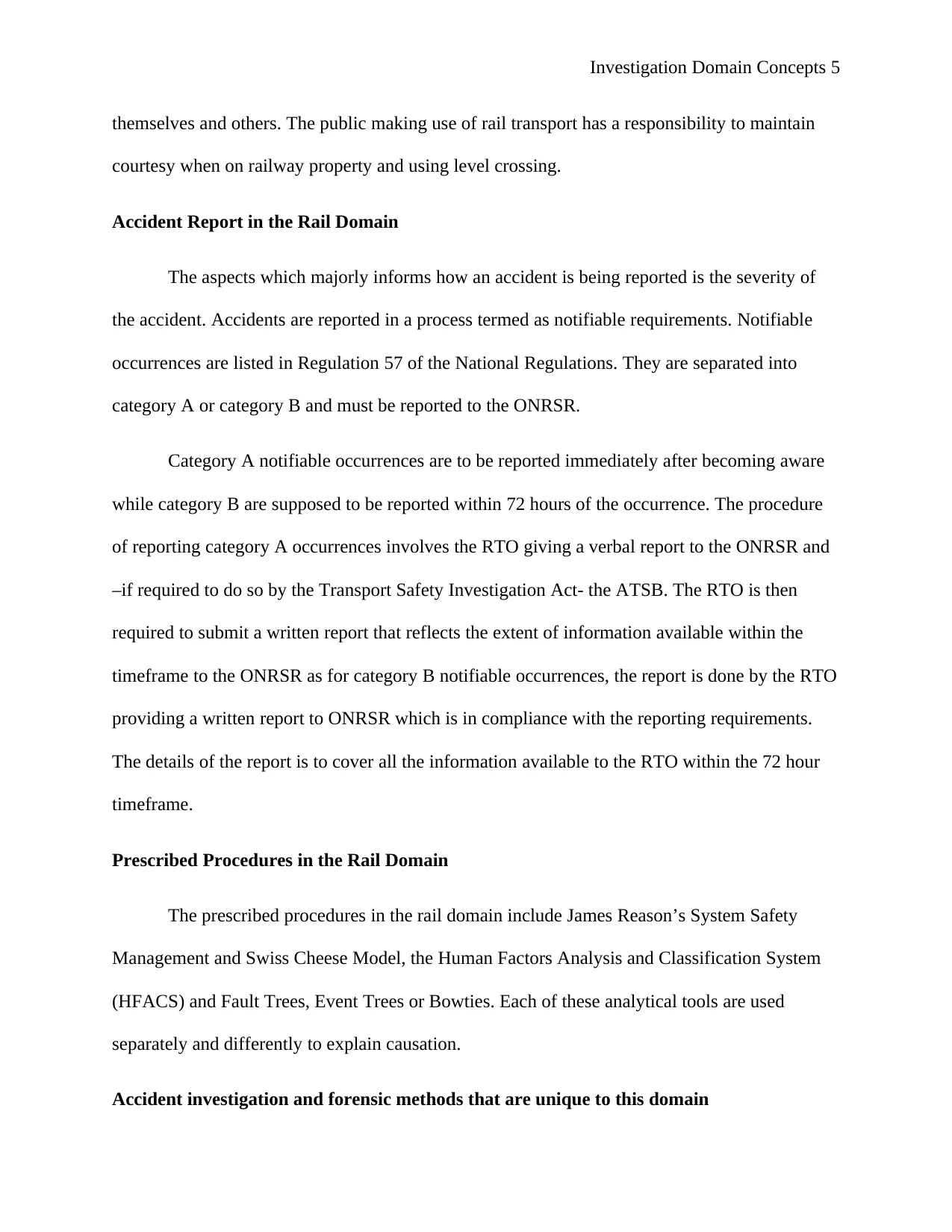
Investigation Domain Concepts 5
themselves and others. The public making use of rail transport has a responsibility to maintain
courtesy when on railway property and using level crossing.
Accident Report in the Rail Domain
The aspects which majorly informs how an accident is being reported is the severity of
the accident. Accidents are reported in a process termed as notifiable requirements. Notifiable
occurrences are listed in Regulation 57 of the National Regulations. They are separated into
category A or category B and must be reported to the ONRSR.
Category A notifiable occurrences are to be reported immediately after becoming aware
while category B are supposed to be reported within 72 hours of the occurrence. The procedure
of reporting category A occurrences involves the RTO giving a verbal report to the ONRSR and
–if required to do so by the Transport Safety Investigation Act- the ATSB. The RTO is then
required to submit a written report that reflects the extent of information available within the
timeframe to the ONRSR as for category B notifiable occurrences, the report is done by the RTO
providing a written report to ONRSR which is in compliance with the reporting requirements.
The details of the report is to cover all the information available to the RTO within the 72 hour
timeframe.
Prescribed Procedures in the Rail Domain
The prescribed procedures in the rail domain include James Reason’s System Safety
Management and Swiss Cheese Model, the Human Factors Analysis and Classification System
(HFACS) and Fault Trees, Event Trees or Bowties. Each of these analytical tools are used
separately and differently to explain causation.
Accident investigation and forensic methods that are unique to this domain
themselves and others. The public making use of rail transport has a responsibility to maintain
courtesy when on railway property and using level crossing.
Accident Report in the Rail Domain
The aspects which majorly informs how an accident is being reported is the severity of
the accident. Accidents are reported in a process termed as notifiable requirements. Notifiable
occurrences are listed in Regulation 57 of the National Regulations. They are separated into
category A or category B and must be reported to the ONRSR.
Category A notifiable occurrences are to be reported immediately after becoming aware
while category B are supposed to be reported within 72 hours of the occurrence. The procedure
of reporting category A occurrences involves the RTO giving a verbal report to the ONRSR and
–if required to do so by the Transport Safety Investigation Act- the ATSB. The RTO is then
required to submit a written report that reflects the extent of information available within the
timeframe to the ONRSR as for category B notifiable occurrences, the report is done by the RTO
providing a written report to ONRSR which is in compliance with the reporting requirements.
The details of the report is to cover all the information available to the RTO within the 72 hour
timeframe.
Prescribed Procedures in the Rail Domain
The prescribed procedures in the rail domain include James Reason’s System Safety
Management and Swiss Cheese Model, the Human Factors Analysis and Classification System
(HFACS) and Fault Trees, Event Trees or Bowties. Each of these analytical tools are used
separately and differently to explain causation.
Accident investigation and forensic methods that are unique to this domain
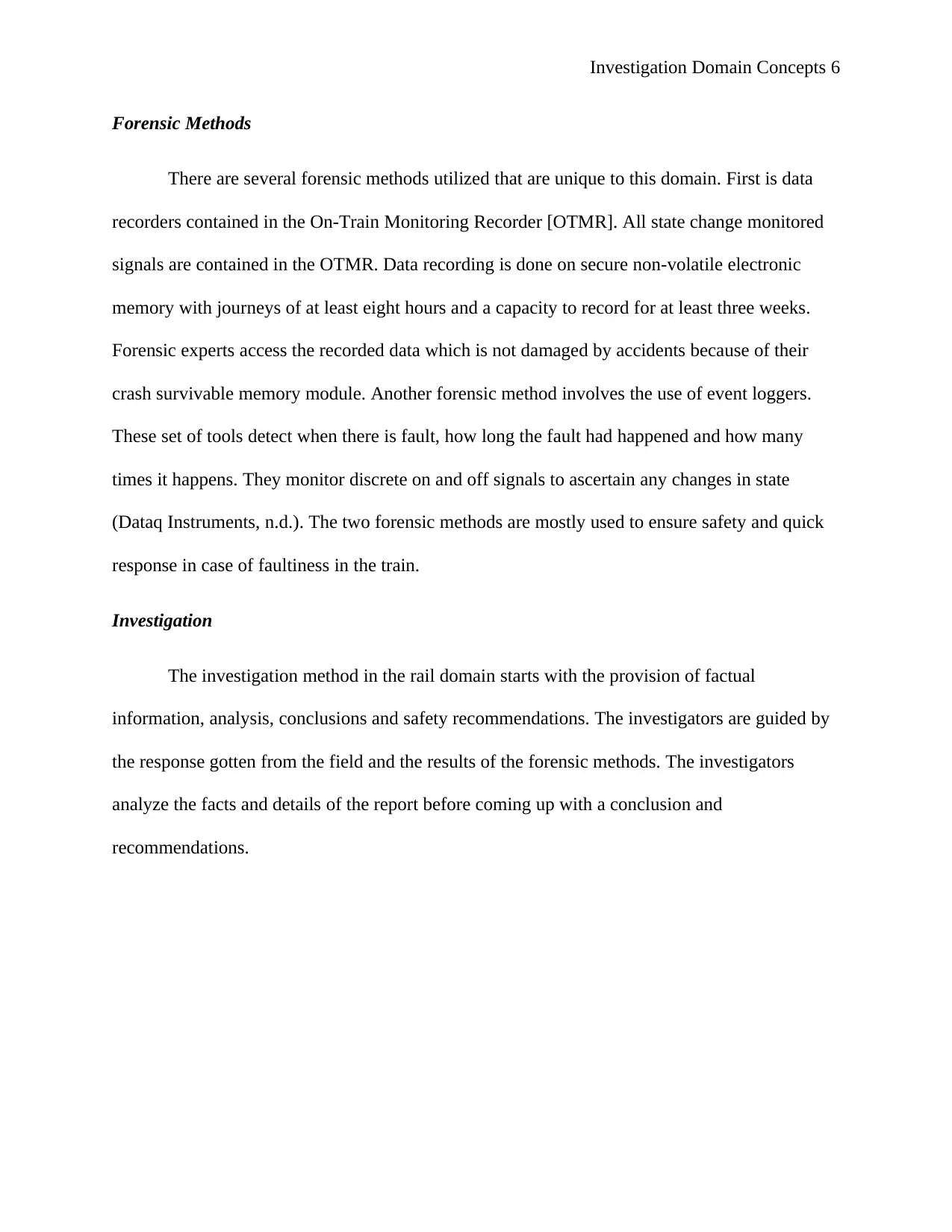
Investigation Domain Concepts 6
Forensic Methods
There are several forensic methods utilized that are unique to this domain. First is data
recorders contained in the On-Train Monitoring Recorder [OTMR]. All state change monitored
signals are contained in the OTMR. Data recording is done on secure non-volatile electronic
memory with journeys of at least eight hours and a capacity to record for at least three weeks.
Forensic experts access the recorded data which is not damaged by accidents because of their
crash survivable memory module. Another forensic method involves the use of event loggers.
These set of tools detect when there is fault, how long the fault had happened and how many
times it happens. They monitor discrete on and off signals to ascertain any changes in state
(Dataq Instruments, n.d.). The two forensic methods are mostly used to ensure safety and quick
response in case of faultiness in the train.
Investigation
The investigation method in the rail domain starts with the provision of factual
information, analysis, conclusions and safety recommendations. The investigators are guided by
the response gotten from the field and the results of the forensic methods. The investigators
analyze the facts and details of the report before coming up with a conclusion and
recommendations.
Forensic Methods
There are several forensic methods utilized that are unique to this domain. First is data
recorders contained in the On-Train Monitoring Recorder [OTMR]. All state change monitored
signals are contained in the OTMR. Data recording is done on secure non-volatile electronic
memory with journeys of at least eight hours and a capacity to record for at least three weeks.
Forensic experts access the recorded data which is not damaged by accidents because of their
crash survivable memory module. Another forensic method involves the use of event loggers.
These set of tools detect when there is fault, how long the fault had happened and how many
times it happens. They monitor discrete on and off signals to ascertain any changes in state
(Dataq Instruments, n.d.). The two forensic methods are mostly used to ensure safety and quick
response in case of faultiness in the train.
Investigation
The investigation method in the rail domain starts with the provision of factual
information, analysis, conclusions and safety recommendations. The investigators are guided by
the response gotten from the field and the results of the forensic methods. The investigators
analyze the facts and details of the report before coming up with a conclusion and
recommendations.
⊘ This is a preview!⊘
Do you want full access?
Subscribe today to unlock all pages.

Trusted by 1+ million students worldwide
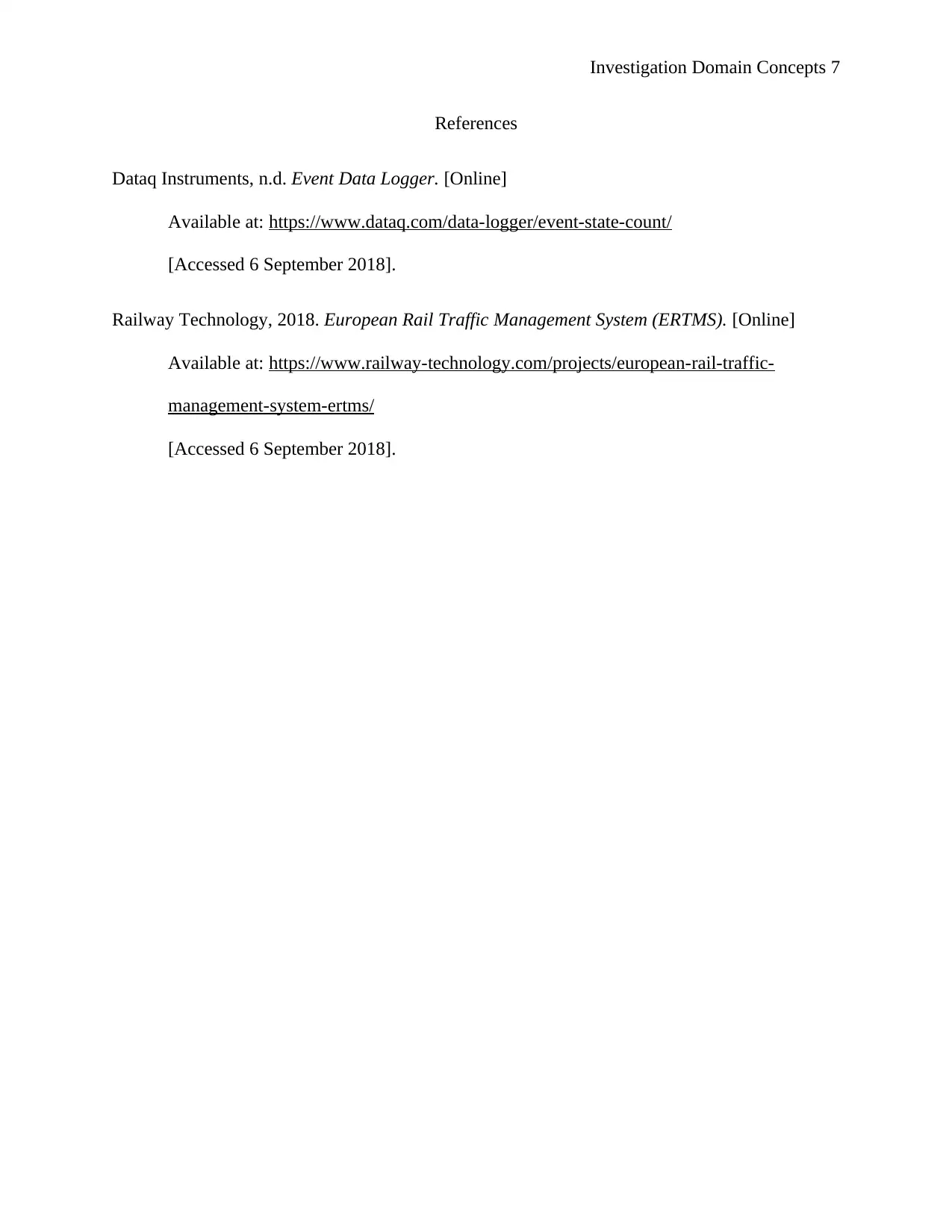
Investigation Domain Concepts 7
References
Dataq Instruments, n.d. Event Data Logger. [Online]
Available at: https://www.dataq.com/data-logger/event-state-count/
[Accessed 6 September 2018].
Railway Technology, 2018. European Rail Traffic Management System (ERTMS). [Online]
Available at: https://www.railway-technology.com/projects/european-rail-traffic-
management-system-ertms/
[Accessed 6 September 2018].
References
Dataq Instruments, n.d. Event Data Logger. [Online]
Available at: https://www.dataq.com/data-logger/event-state-count/
[Accessed 6 September 2018].
Railway Technology, 2018. European Rail Traffic Management System (ERTMS). [Online]
Available at: https://www.railway-technology.com/projects/european-rail-traffic-
management-system-ertms/
[Accessed 6 September 2018].
1 out of 7
Related Documents
Your All-in-One AI-Powered Toolkit for Academic Success.
+13062052269
info@desklib.com
Available 24*7 on WhatsApp / Email
![[object Object]](/_next/static/media/star-bottom.7253800d.svg)
Unlock your academic potential
Copyright © 2020–2025 A2Z Services. All Rights Reserved. Developed and managed by ZUCOL.





